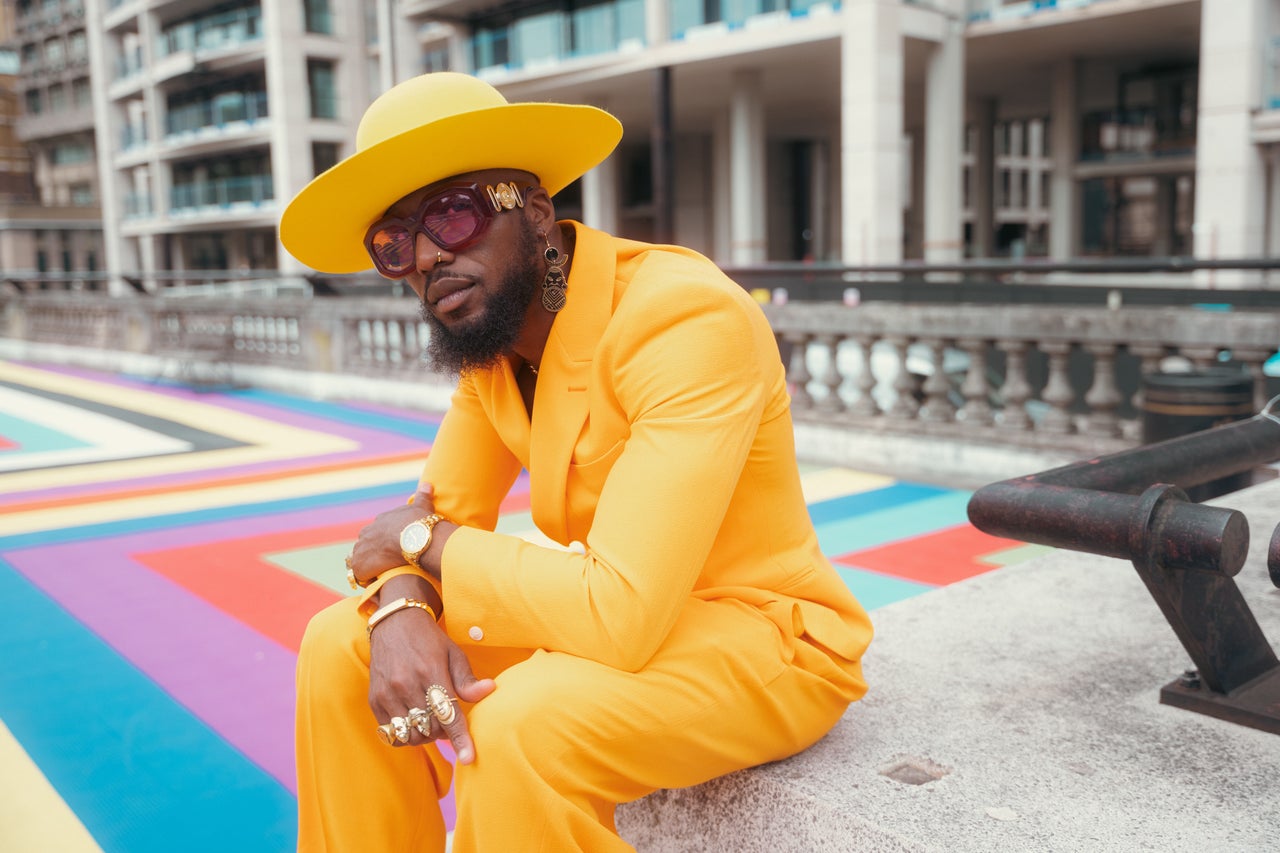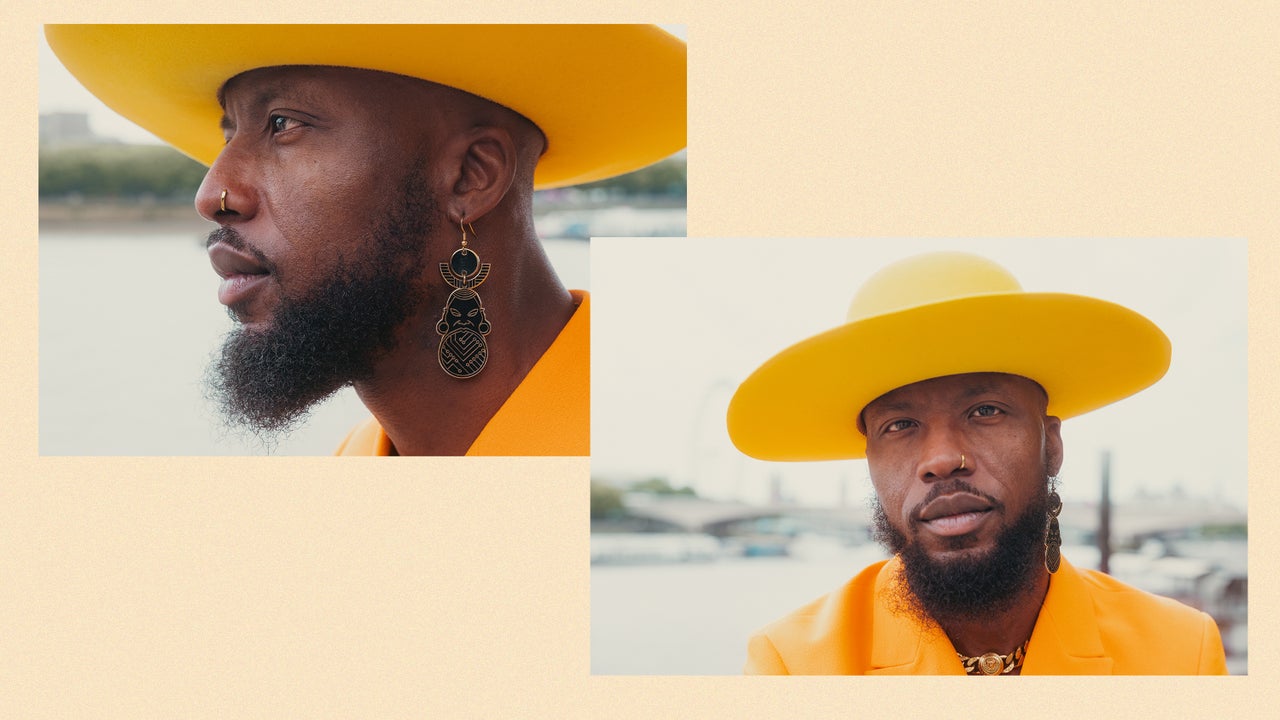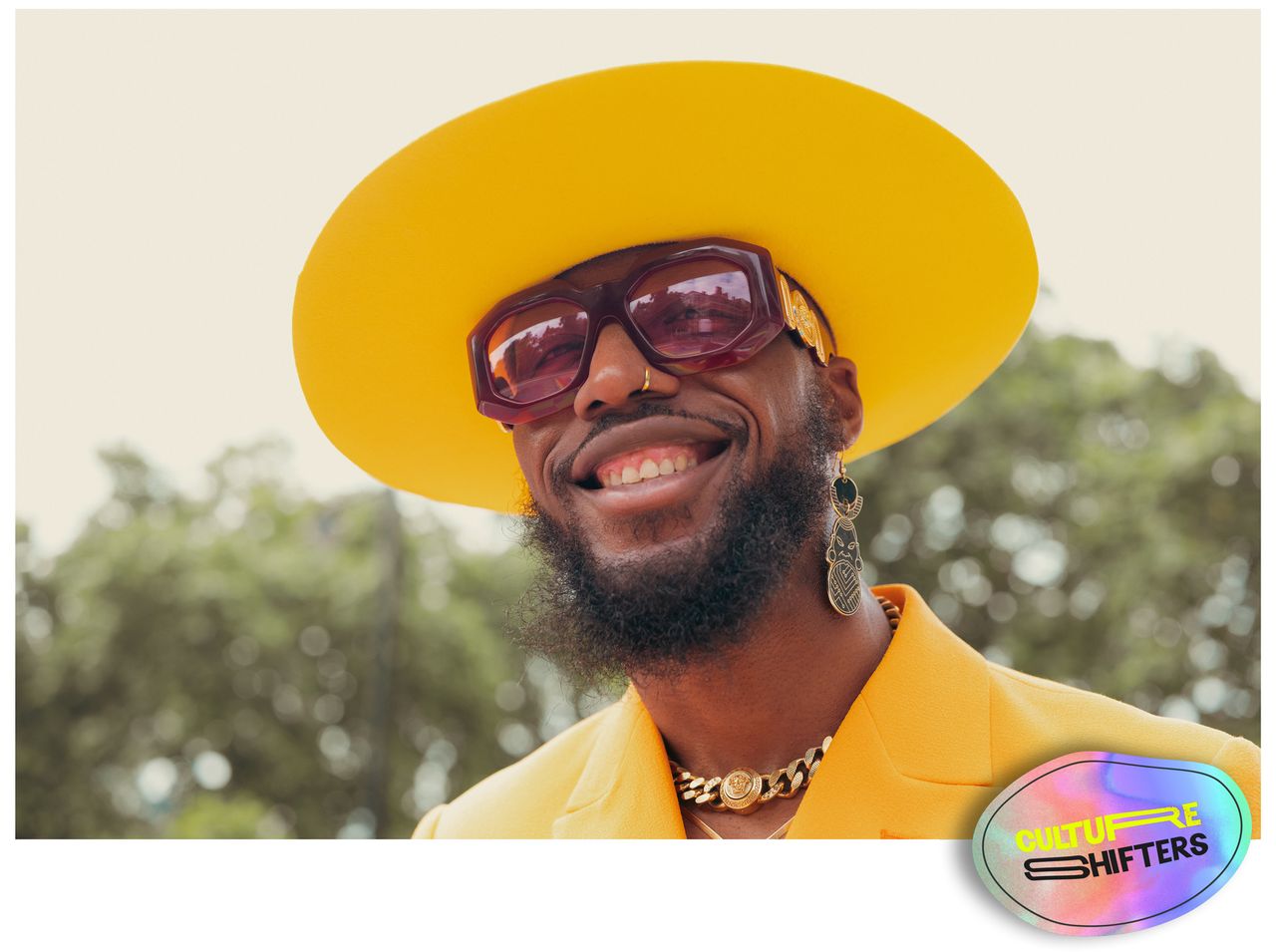This profile is part of our Culture Shifters series, which highlights people who are changing the way we think about the world around us. Read about film archivist Maya Cade, internet stars Keyon Elkins and Drew Afualo, rapper Latashá, music historian Katelina Eccleston, filmmaker Alika Tengan, and actors Rhoyle Ivy King and Nicco Annan.
It’s around 8 p.m. in London, though you couldn’t tell it’s that late on a February evening by looking at artist Kay Rufai. He pops onto our Zoom call with such a wave of positive energy — sporting a lime green shirt with a matching hat, a gold chain necklace and a megawatt smile — that you might assume it’s more like high noon where he is.
“It’s been a good day,” he said, settling into a self-made soundproof booth in his home. “It’s been a busy day, but a good day.”
An indication of how Rufai, 38, spends his stuffed weekdays is perched right behind him in the cubicle: a row of images of Black and brown boys grinning from ear to ear. “They’re ever-present,” he said pleasantly. He is referring to his groundbreaking S.M.I.L.E-ING Boys Project, a photographic well-being initiative specifically designed for Black and brown boys in the Swinging City who are often reduced to dehumanizing stereotypes with no concern for their mental health. Rufai’s ongoing research-led project helps boys access their joy and other aspects of their interior selves around which they often put up boundaries.
Their guardedness is typically a defense mechanism against a city that, even amid today’s cultural reckoning, largely skirts around issues of race, particularly when it comes to the police.
“For example, situations around violence, especially youth violence, is very racialized in the way it’s reported,” Rufai said. “But when there’s anything that’s speaking on the experiences of Black people, or people of minoritized or global majority groups, people get very uncomfortable.”
Some of the words used to refer to Black and brown boys in the media, he says, “are so nondescript.” That language bunches kids together with no care for who they are as individuals. It particularly dismays Rufai because he grew up in some of the same neighborhoods where these boys live, in the same circumstances as many of them. He has also worked with young people who have been in and out of prison or in gangs.
“I knew that these are not deterrents,” he said. “We know what the recidivism rates are. I wanted to create a project that was rooted in centering the mental health disproportionalities,” since “no doubt violence is a manifestation of that.”
It becomes clear that this is a cause close to Rufai’s heart. “Aggressive behavior, or all these other things that are perceived as aggressive behavior or dangerous behavior,” he said. “All these other things were manifestations of lack of mental health provisions for this demographic.”
The S.M.I.L.E-ING Boys Project ― the acronym stands for Send Me Inspiring Loving Energy ― creates a safe space for boys to be their full selves, opening up dialogues around topics like aesthetics, money, health and masculinity. Ultimately, the idea is to empower the boys to walk confidently in their truths each day.
Rufai captures that sense of freedom by the end of this eight-week process, when the boys’ smiling faces practically beam out of his photographs. But first, he has to meet them where they are psychologically and emotionally ― typically in a school setting ― and establish a mutual trust.

“So, I walk into a classroom with 13-year-old boys, and I let them know that your voice is equally as valid as mine,” he explained. “You don’t have to respect me because I’m older. You just have to respect me because you command respect and therefore you give the same to me.”
Once Rufai establishes this level playing field, the boys begin to behave in ways that feel more comfortable to them at this stage — whether that means throwing in a swear word here and there, expressing fear, sadness or anger, or vocalizing a thought that was previously difficult for them to share. The one caveat: Rufai can challenge them on what they say and encourage them to think more deeply about things, even if the subject is him.
“Around the third session, I ask them what they really thought about me when I first stepped into the room wearing all these bright clothes,” Rufai recalled. “And a lot of the times they say, ‘I thought you were gay. I thought you was, whatever.’ I’m not going to be offended by it.”
Instead, he empowers them to explain how they came to that perspective: “I’m just really interested in what you thought. ‘We thought you were so non-masculine because you wore yellow, pink and all of this.’ We start to unpack that.”
Rufai’s own youth is part of why he’s made it his life’s work to embolden Black boys to use their voices to unlock who they really are, regardless of what they believe or have been told to believe about themselves. A son of Nigerian immigrants, the artist, born with the first name Adekunle, was always taught two things: Go to university, and become a doctor. “Make your life worth living,” he said.
To be fair, Rufai tried that route. He took some coursework and was on a path to study medicine. But by the third year, he became frustrated and restless. “I didn’t want to study that,” he recalled. “I absolutely hated being in the university.”
He channeled that agitation into his then-untapped creative side. “While I was there, I spent a lot more time writing and expressing myself,” he said. “I would just escape. Even though [I was] in the physical confines of a lecture hall, I would mentally and emotionally and spiritually be elsewhere, writing and creating.”
This allowed Rufai to tap into, and eventually nurture, his artistic passions like poetry, photography and music. But it also meant he would have to dive into some of his own vulnerabilities that he protected from the world around him. These included growing up without his father and navigating life as a Black boy and young man.
It wasn’t until later in life that Rufai realized he was using these outlets as his own path toward mental health, and “as a tool to help process some of the complex emotions that I had,” he said. “Because I was very aware of the range of emotions that I was navigating through, but I didn’t actually have language for most of it.”
But he found himself more and more drawn to these artistic expressions as he continued to experience life ― primarily in London, but also in Nigeria and the United States. It gave him something he felt he was missing for a long time. “I really gravitated to music,” he said. “It kind of filled that void. I listened to voices of people like Lauryn Hill and Tupac [Shakur], who were significant staples for me growing up in terms of understanding myself and my identity as a Black kid and really navigating those expressions.”

You could describe what came later for Rufai as double-edged. He dropped out of university to begin performing and honing his art, which filled him with unbridled joy. But that shift was met with his mother’s disapproval, which he says made it “a very tough period.”
Still, betting on himself ended up being an invaluable move for him, and for so many others like him. Because when Rufai, restless once again, decided that he wanted his art to engage with Black boys like him on a more intimate level, he gave them permission to actively and intentionally seek their own happiness with initiatives like the S.M.I.L.E-ing Boys Project.
“I created this project because the 13-year-old version of myself needed it,” Rufai said. He admits that looking after his mental health is still a conscious effort on his part each day. Since he hasn’t been able to travel as much as he’d like in the pandemic, he’s relied on walking along the river near his home and turning on some music and dancing in the living room.
“I’m moonwalking and just being full of joy in my physical being and my body,” he laughed. “I really just enjoy listening to music that brings joy to my soul. Knowing that a lot of the work that I do is outwardly exerting, I recognize that I have to feed this so that I can be of service.”
Still, being in a classroom with boys, seeing them begin to open up, remains his most significant source of joy — one that took him much soul-searching to accomplish, and one that has gifted him with other cultural initiatives around London in addition to his own self-fulfillment.
“This work that I do is a radical reinstatement of joy in my life,” Rufai beams. “Curating a space of Black boys that look like me and like each other, for them to be playful, fun. For me to get to be a kid again — because I’m there jumping on chairs, and we play games together.”
He pauses, before adding proudly: “We speak openly. We bond. That brings so much joy to me.”
